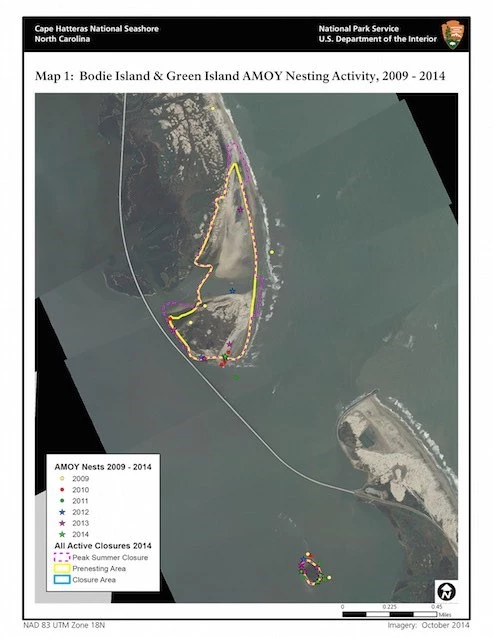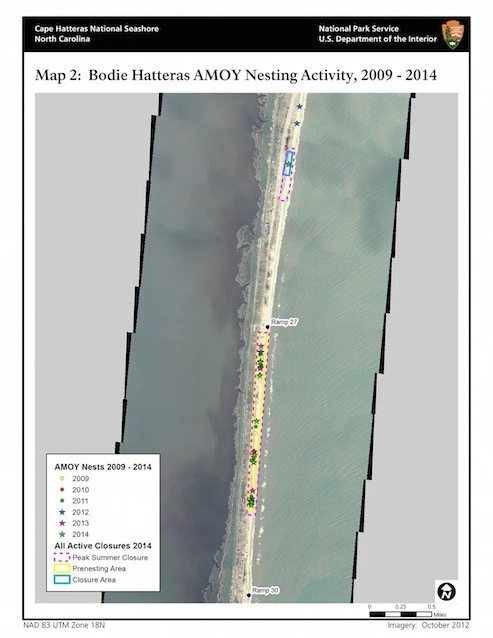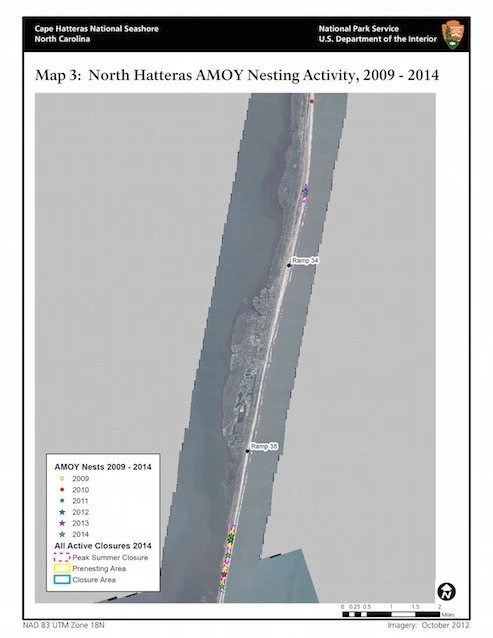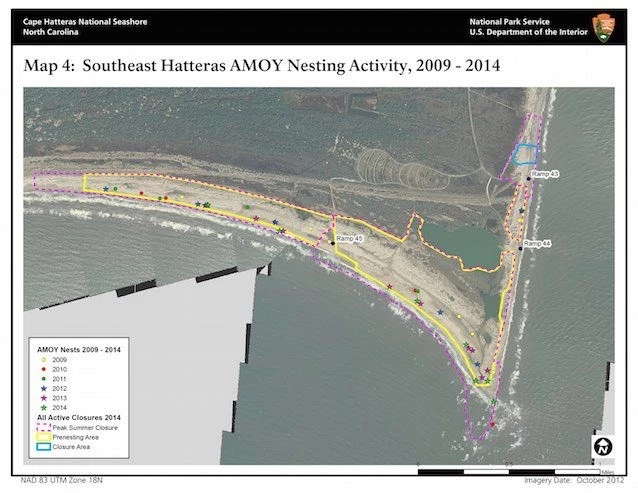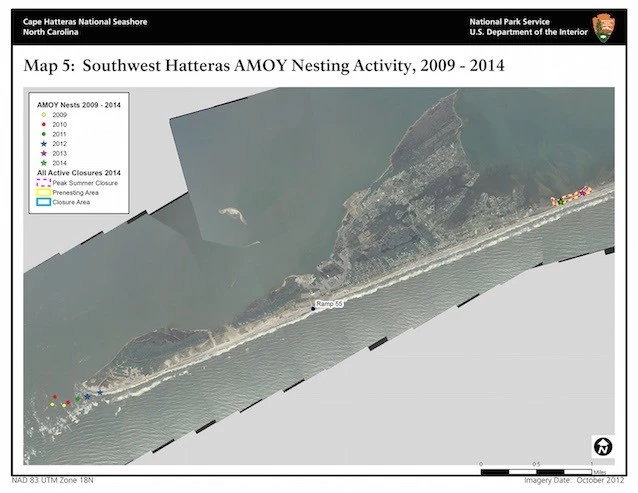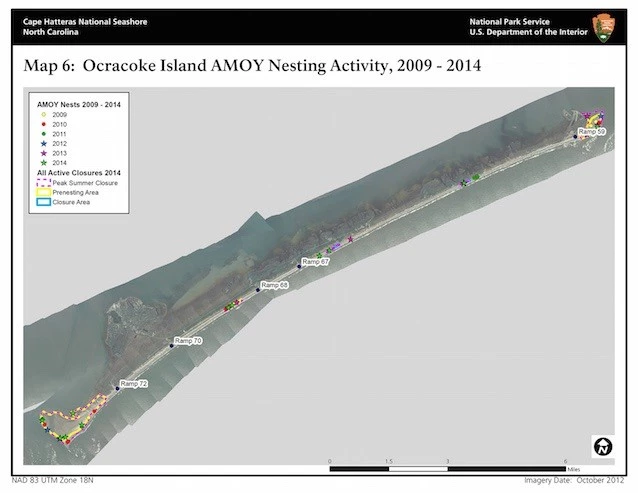Last updated: January 6, 2018
Article
2014 American Oystercatcher Annual Report Cape Hatteras
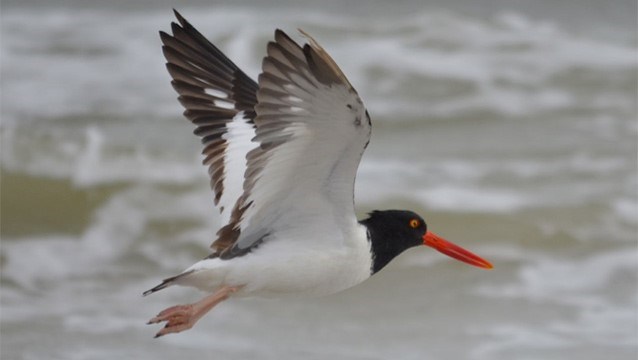
In 2014, 26 pairs of American oystercatchers (AMOY) nested at Cape Hatteras National Seashore (CAHA). A total of 38 nests were identified in the park which includes re-nests from pairs with failed nest attempts. Of these nests, 18 hatched and produced a total of 31 chicks. Eight pairs of AMOY were successful in fledging nine chicks which represents a 0.35 fledge rate per pair.
Introduction
The AMOY is a ground-nesting shorebird native to North Carolina. As with many shorebirds, oystercatcher numbers have been in sharp decline over the past 20 years. The AMOY is designated as a Species of Special Concern by the U.S. Fish and Wildlife Service (USFWS) in North Carolina. Habitat loss and fragmentation due to beach development has resulted in nesting attempts in marginal habitat. Nesting attempts in marginal habitat is thought to lead to an increased number of unsuccessful breeding attempts. Off-road-vehicle (ORV) use on the beach can lead to direct mortality of chicks and eggs and pedestrian disturbance can indirectly cause loss of nests or chicks. The main cause of direct mortality of chicks and eggs is believed to be mammalian predators. Studies suggest that there is also an interaction between human presence and predation events by mammals. (McGowan 2004) (McGowan and Simons 2006).
ORV Management Plan
On February 15, 2012 the ORV Management Plan was enacted at CAHA. It was developed from 2007-2012 and was accompanied by a special regulation detailing requirements for ORV use at CAHA. A copy of the ORV Management Plan and other related documents are available electronically at https://parkplanning.nps.gov/caha. It includes establishment of an ORV permit system to drive on CAHA beaches. It also establishes pre-nesting closures and buffer requirements for nesting birds and chicks. This was the third year the ORV Management Plan guided the management of protected species at CAHA.
Methods
Cape Hatteras National Seashore employs a number of methods in the monitoring and protection of breeding AMOY. These include protection of back-shore habitat; installing pre-nesting closures for birds exhibiting territorial behavior; monitoring of breeding pairs, nests and chicks; banding of juvenile AMOY; removing predators; and adaptively moving closure boundaries to comply with the required buffers of the ORV Management Plan for nests and chicks. Chick movements were monitored daily to ensure they were adequately protected by the established buffers. Breeding behavior is defined as courtship, mating, scraping or other nest-building activities by birds setting up in new or previously established territories. Breeding behavior, nests and scrapes received 150 meter buffers to reduce possible disturbance to courting or incubating adults. Once the nests hatched, 200 meter buffers were maintained around the chicks. Larger buffers were used if individual birds were observed to be disturbed at these distances.
Closures
Pre-nesting closures for AMOY were installed in areas where the habitat was suitable for nesting and where nesting has occurred in more than one of the past five years. As per the ORV Management Plan, AMOY required a 150-meter buffer for breeding behavior, scrapes and nests and a 200-meter buffer for unfledged chicks. When multiple species were present, the greatest applicable buffer distance was used. In 2014, 22 AMOY breeding pairs held territories within the pre-nesting closures and 32 of the 38 AMOY nesting attempts occurred inside the pre-nesting closures (Appendix A; Maps 1-6).
Monitoring
Breeding pairs of AMOY were located by surveying potential habitat including ocean-side beaches and sound-side beaches. Birds were monitored closely for nesting when observed regularly at the same location or when demonstrating territorial or breeding displays. If nests or scrapes were found, observers marked the location with a handheld GPS unit. Closures were installed (or modified) as necessary to maintain the required buffer distance(s).
Incubating pairs with nests were monitored daily and observed even more closely near expected hatch dates. Expected hatch dates were calculated from an average nest incubation period for AMOY as 29 days from first egg laid or 24 days from last egg laid (Baicich and Harrison 1997). If an incubating bird was not observed on the nest, the nest was checked for the presence of eggs and, if the eggs were missing, the area was inspected for signs of predators. Once chicks hatched, staff attempted to observe each chick daily barring severe weather.
Chick Movement
After hatching, staff installed a minimum buffer of 200 meters around AMOY chicks. Chicks have been observed to move as much as 100 meters on the first day after hatching and up to 500 meters or more within the first week after hatching. As the chicks commenced their movement away from the nest sites the closures were expanded when necessary to ensure adequate buffers.
Nonbreeding AMOY Surveys
Three surveys were conducted in all park districts from June 1 to June 9 to account for nonbreeding AMOY. Nonbreeding AMOY are lone birds and pairs of birds, both unbanded and banded, unassociated with nests at CAHA. Surveys were conducted on the same dates in all park districts and a GPS point was taken for each AMOY observed. After the conclusion of the breeding season the highest daily number of nonbreeding AMOY for the seashore over the three survey dates was recorded.
Predator Control
Because mammalian predation is a major factor in AMOY nest loss and chick mortality (McGowan 2004), predator control by trapping was conducted to target predators near nests and chicks in 2014. Trapping was conducted in all park districts. When technicians surveyed areas they documented and reported any signs (prints, scat, etc.) of predators they observed. If predator sign was found in a closure, trapping efforts were increased in that area with the intent of targeting the specific predator in that area.
Banding
In addition to carrying out actions required by the ORV Management Plan, resource management staff banded AMOY chicks under North Carolina State University’s (NCSU) banding permit. Banding aids in tracking survival of individuals, determining breeding success of individual pairs, documenting movement of young birds to other areas, and aids in determining breeding site fidelity. Being able to identify individual birds has also allowed NCSU and CAHA staff to coordinate data with scientists from other states to examine genetics, migration patterns, and long-term survival rates of the AMOY population.
Results
In 2014, 26 pairs of AMOY nested at CAHA. One pair was found on Bodie Island, 13 were found on Hatteras, nine were found on Ocracoke, and three were found on Green Island. Altogether, these pairs produced a total of 38 nests, including re-nests, of which 18 nests hatched.
Eight pairs were successful in fledging nine chicks which represents a 0.35 fledge rate per pair (Table 1). Although the chicks fledged per breeding pair at CAHA appears to be cyclical, there is generally an increasing trend in productivity when looked at over multiple years (Figure 1).
|
Table 1. Summary of AMOY Reproductive Success 2009–2014 |
||||||
|
Year |
Breeding |
Total |
Nests |
Successful Pairs |
Number of |
Fledge |
|
2009 |
23 |
31 |
15 |
8 |
13 |
0.56 |
|
2010 |
23 |
28 |
21 |
15 |
30 |
1.3 |
|
2011 |
23 |
26 |
22 |
17 |
28 |
1.2 |
|
2012 |
22 |
30 |
18 |
11 |
15 |
0.68 |
|
2013 |
271 |
42 |
19 |
10 |
15 |
0.55 |
|
2014 |
26 |
38 |
18 |
8 |
9 |
0.35 |
1 Could also be calculated as 26 pairs. One male AMOY nested twice, each time with a different female.
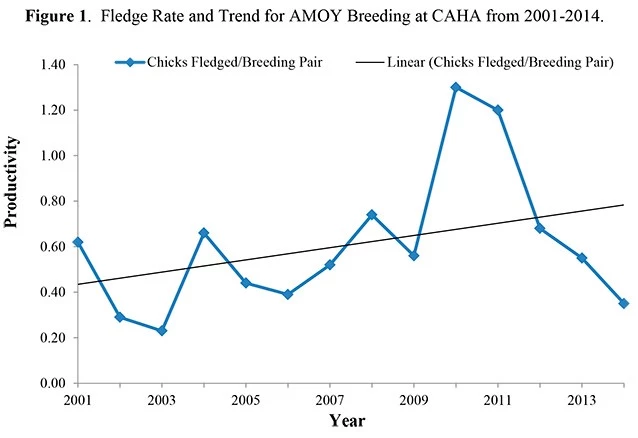
The first nest of the season was found on April 4, 2014 and the last nest was found on June 12, 2014. For the 16 nests with known start dates, the average incubation period was 31.5 days. For the eight broods which fledged chicks, the average age of chicks when they fledged was 43 days old. This average does not include separate dates for individuals within a brood but is based on the date of the first chick to fledge from each brood.
Nest Failures and Chick Mortality
Twenty nests were lost in 2014 breeding season. One nest was lost to storm overwash, one nest was lost during Hurricane Arthur, three nests were abandoned, and 15 nests were lost to predation. It is difficult to attribute nest loss to an exact species if the predation is not directly observed. Field cameras documented at least one red fox predating a nest on Hatteras Island. Mammalian, ghost crab and avian predators are believed to be responsible for the other 14 nests lost to predation.
Determining cause of chick loss is even more difficult than determining cause of nest loss. In the 2014 season there were ten complete brood failures and six partial brood failures. Chicks can move large distances and it is sometimes difficult to locate them. Environmental conditions surrounding the brood site may obscure evidence of predation and searches for missing chicks may be intentionally delayed since many different types of disturbances may cause the chicks to hide out of view from the observers.
Nonbreeding AMOY Surveys
Three surveys were conducted in all park districts on June 2, 4, and 6, 2014 to account for nonbreeding AMOY. A GPS point was taken for each AMOY observed and breeding pairs were identified after the breeding season concluded. Twenty-six nonbreeding AMOY were observed on June 2, 2014. One was observed on Bodie Island, seven on Hatteras Island and 18 on Ocracoke Island. The age of many of the banded birds is known and some were of age to nest in 2014, but did not, either due to their inability to find, establish and hold a territory, or inability to find a mate of breeding age. Other observed birds will first come into breeding age in 2015.
Human Disturbance
Human disturbance, direct or indirect, can lead to the abandonment of nests or loss of chicks. Throughout the season, resource management staff documented 181 pedestrian, nine ORV, and 33 dog, boat or horse intrusions in the AMOY nesting closures. The numbers are conservative since sites are not monitored continuously, weather erases tracks, and staff does not disturb incubating pairs or young in order to document disturbance. These numbers indicate violations to closures specifically containing nesting AMOY or habitat protected for AMOY. It is important to note that most of the closures contained multiple species, including AMOY, colonial waterbirds, and piping plovers. Most illegal entries were not witnessed, but documented based on vehicle, pedestrian, or dog tracks left in the sand. Pedestrian entry most often required visitors to lift or stoop under the string that connected all posted signs, while vehicular entry required visitors to drive through or around a sign boundary. Visitors’ unleashed dogs are also a threat to protected species and continue to be a problem.
Banded AMOY
In 2014, CAHA RM staff banded eight chicks with uniquely identifiable bands. A total of 209 AMOY have been banded at CAHA since 2002 consisting of 48 adults and 161 chicks. As the result of this long term cooperative banding project with NCSU, CAHA has begun to document banded chicks surviving to adulthood and joining the breeding population. Banded birds enabled staff to identify breeding pairs and unpaired individuals with confidence.
Discussion
In 2014, three new AMOY pairs and two new individuals joined the CAHA breeding population for a total of 26 AMOY pairs. These pairs produced 38 nests. Despite the second highest number of pairs and nests since 2001, the fledge rate of 0.35 is lower than previous years. Increased mammalian predations attributed to low hatch and fledge rates. The high number of predation incidents could also be responsible for the increased number of nests. Of the 23 pairs with known nesting dates, ten pairs re-nested at least once after their nest was depredated.
Field staff are trained to identify breeding behaviors associated with territory establishment to allow for the immediate protection of these areas. Adequate protection from disturbance and a continuation of the predator control program should result in a continued increase in population and successful AMOY pairs at CAHA over time.
References
Baicich, P.J. and C.J.O. Harrison. A Guide to the Nests, Eggs, and Nestlings of North American Birds (Second edition). Natural World Academic Press, New York. 1997.
McGowan, C.P., 2004. Factors affecting nesting success of American Oystercatchers (Haematopus palliatus) in North Carolina. Unpublished M. Sc. Thesis, North Carolina State Universtiy, Raleigh, North Carolina.
McGowan, C.P., T.R. Simons, 2006. Effects of human recreation on the incubation behavior of American Oystercatchers. The Wilson Journal of Ornithology 118:485-493.
United States. Dept of Interior. National Park Service. 2010. Cape Hatteras National Seashore Off-Road Vehicle Management Plan and Special Regulation.” 36 CFR 7. 2012. Print.
CAHA AMOY 2014 - A. Appendix A: Maps
